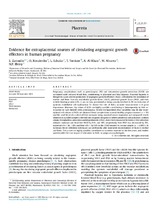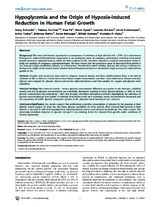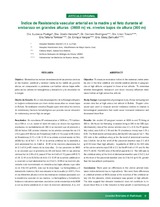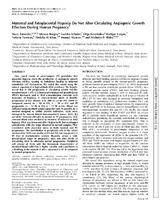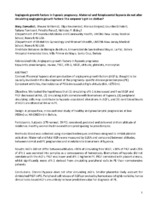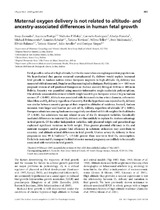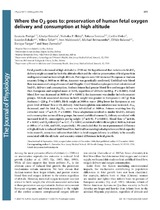Listar Producción científica por autor "Zamudio, Stacy"
Mostrando ítems 1-7 de 7
-
Evidence for extraplacental sources of circulating angiogenic growth effectors in human pregnancy
Zamudio, Stacy; Kovalenko, Olga; Echalar, Lourdes; Torricos, T; Al-Khan, A; Álvarez, M; Illsley, Nicholas P (Placenta, 2013-08-24)Abastract. Pregnancy complications such as preeclampsia (PE) and intrauterine growth restriction (IUGR) are associated with reduced blood flow, contributing to placental and fetal hypoxia. Placental hypoxia is thought ... -
Hypoglycemia and the origin of hypoxia-induced reduction in human fetal growth
Zamudio, Stacy; Torricos, Tatiana; Fik, Ewa; Oyala, María; Echalar, Lourdes; Pullockaran, Janet; Tutino, Emily; Martin, Brittney; Belliappa, Sonia; Balanza, Elfride; Illsley, Nicholas P (PLOS One, 2010-01)Abtract. Background: The most well known reproductive consequence of residence at high altitude (HA .2700 m) is reduction in fetal growth. Reduced fetoplacental oxygenation is an underlying cause of pregnancy pathologies, ... -
Índice de resistencia vascular arterial en la madre y el feto durante el embarazo en grandes alturas (3600 m) vs. niveles bajos de altura (300 m)
Postigo, Lucrecia; Heredia, Gladis; Rodríguez, Carmelo; Toledo, Lilian; Torricos, Tatiana; Vargas, Enrique; Zamudio, Stacy (Revista de la Sociedad Boliviana de Radiología, 2007)Resumen. Objetivo: Determinar los índices de resistencia de las arterias uterinas en las madres, umbilical y cerebral media en los bebés de grandes alturas, en comparación a pacientes que habitan alturas bajas reflejados ... -
Maternal and fetoplacental hypoxia do not alter circulating angiogenec growth effectors during human pregnancy
Zamudio, Stacy; Borges, Marcus; Echalar, Lourdes; Kovalenko, Olga; Vargas, Enrique; Torricos, Tatiana; Al Khan, Abdulla; Álvarez, Manuel; Illsley, Nicholas P (Biol Reprod., 2014-02-27)Abstract. One causal model of preeclampsia (PE) postulates that placental hypoxia alters the production of angiogenic growth effectors (AGEs), causing an imbalance leading to maternal endothelial cell dysfunction. We ... -
Maternal and fetoplacental hypoxia do not alter circulating angiogenic growth factors : the emperor's got no clothes?
Zamudio, Stacy; Williams, Shauna; Kovalenko, Olga; Borges, Marcus; Echalar, Lourdes; Torricos, Tatiana; Paiva, Priscilla; Illsley, Nicholas P (The Journal of Clinical Endocrinology & Metabolism, 2010)ABSTRACT. Context: Placental hypoxia alters production of angiogenic growth factors (AGFs), thought to be causally involved in the development of the pregnancy-specific disease preeclampsia (PE). Consistent with this, ... -
Maternal oxygen delivery is not related to altitude- and ancestry-associated differences in human fetal growth
Zamudio, Stacy; Postigo, Lucrecia; Illsley, Nicholas P; Rodríguez, Carmelo; Heredia, Gladys; Brimacombe, Michael; Echalar, Lourdes; Torricos, Tatiana; Téllez, Wilma; Maldonado, Iván; Balanza Erquicia, Elfride; Álvarez, Tatiana; Ameller, Julio; Vargas, Enrique (J Physiol, 2007-09-16)Fetal growth is reduced at high altitude, but the decrease is less among long-resident populations. We hypothesized that greater maternal uteroplacental O2 delivery would explain increased fetal growth in Andean natives ... -
Where the O2 goes to : preservation of human fetal oxygen delivery and consumption at high altitude
Postigo, Lucrecia; Heredia, Gladys; Illsley, Nicholas P; Torricos, Tatiana; Dolan, Caitlin; Echalar, Lourdes; Téllez, Wilma; Maldonado, Iván; Brimacombe, Michael; Balanza, Elfride; Vargas, Enrique; Zamudio, Stacy (The Journal of Physiology, 2009)Fetal growth is decreased at high altitude (> 2700 m). We hypothesized that variation in fetal O2 delivery might account for both the altitude effect and the relative preservation of fetal growth in multigenerational ...

